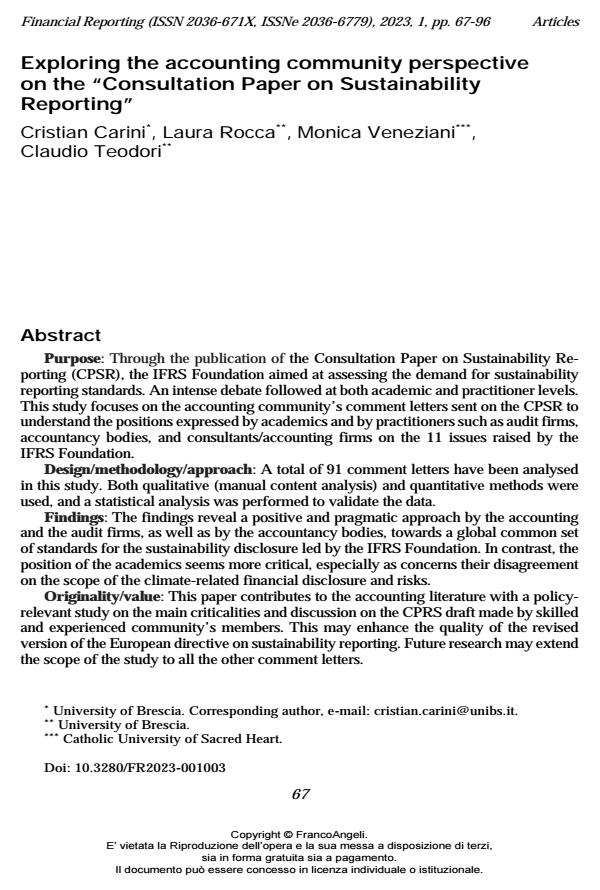Exploring the accounting community perspective on the "Consultation Paper on Sustainability Reporting"
Journal title FINANCIAL REPORTING
Author/s Cristian Carini, Laura Rocca, Monica Veneziani, Claudio Teodori
Publishing Year 2023 Issue 2023/1
Language English Pages 30 P. 67-96 File size 179 KB
DOI 10.3280/FR2023-001003
DOI is like a bar code for intellectual property: to have more infomation
click here
Below, you can see the article first page
If you want to buy this article in PDF format, you can do it, following the instructions to buy download credits

FrancoAngeli is member of Publishers International Linking Association, Inc (PILA), a not-for-profit association which run the CrossRef service enabling links to and from online scholarly content.
The International Accounting Standards Board (IASB) in January 2020 is-sued “Classification of Liabilities as Current or Non-current”, which amended IAS 1 Presentation of Financial Statements. The main purpose of the amend-ments regards the classification of financial liabilities and how to classify them under particular circumstances. The amendments are proposed to be effective for annual reporting periods beginning on or after 1 January 2023, with earlier application permitted. Due to feedback received and enquiries about the classification of financial liabilities with financial covenants, in December 2020 the IFRS Interpretations Committee (IFRIC) published a tentative agenda decision in response to such feedback. Subsequently, in October 2022 the International Accounting Stand-ards Board (IASB) published a document titled “Non-current Liabilities with Covenants (Amendments to IAS 1)”. The purpose of this document is to clarify the conditions with which an entity must comply within twelve months after the reporting period affect the classification of a liability. The amendments are ef-fective for reporting periods beginning on or after 1 January 2024. The classification of financial liabilities as current or non-current is an im-portant consideration for financial reporting purposes, as it can have a significant impact on a company’s financial statements and financial ratios. Current liabili-ties are those that are expected to be settled within one year, while non-current liabilities are those that are expected to be settled beyond that time frame. The purpose of the following review is to analyse the main impacts of the amendments on the classification of the financial liabilities with covenants and the project’s history and timeline.
Keywords: IAS 1, liabilities, presentation, current/non current, financial cove-nants.
- Using Chatbots to Enhance Integrated Reporting: Insights from Accounting and Consultancy Companies from Romania Carmen Elena Anton, Eliza Ciobanu, Gabriel Brătucu, Loránt Bucs, in Electronics /2024 pp.4801
DOI: 10.3390/electronics13234801 - The Readability of Non-Financial Information. The Role of Stakeholders' Pressure in the European Setting Alessandra Allini, Begona Giner, Marco Maffei, Annamaria Zampella, in Accounting in Europe /2024 pp.1
DOI: 10.1080/17449480.2024.2380312
Cristian Carini, Laura Rocca, Monica Veneziani, Claudio Teodori, Exploring the accounting community perspective on the "Consultation Paper on Sustainability Reporting" in "FINANCIAL REPORTING" 1/2023, pp 67-96, DOI: 10.3280/FR2023-001003